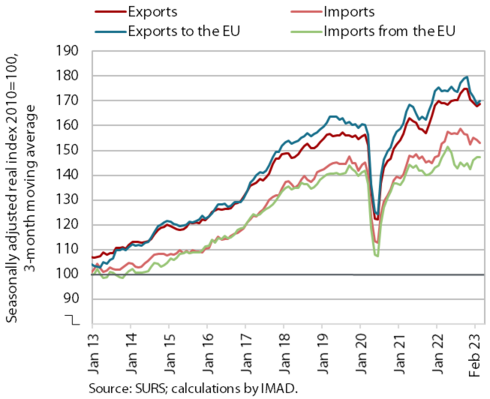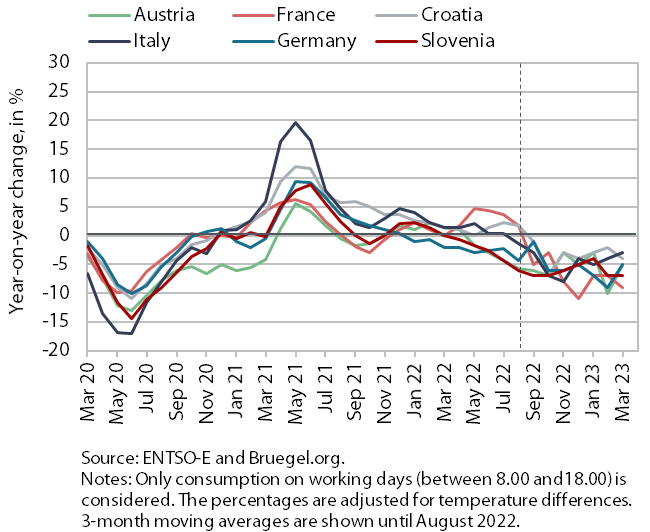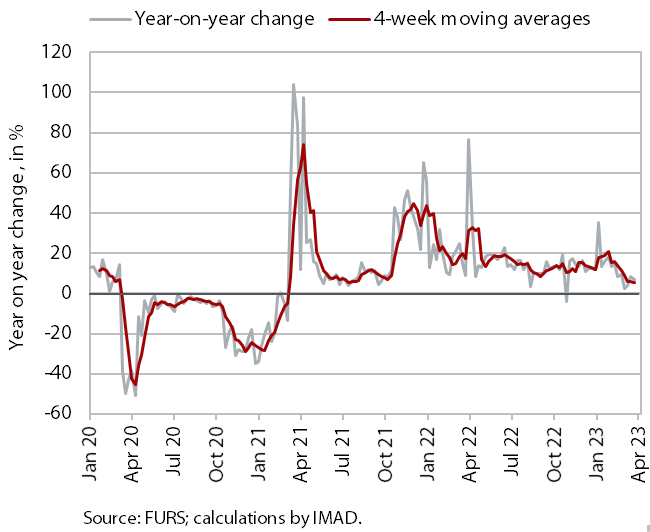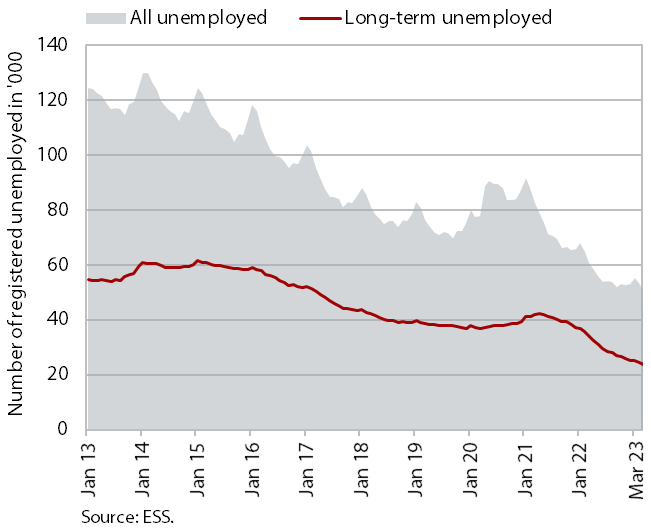Charts of the Week
Charts of the week from 3 to 7 April 2023: trade in goods, electricity consumption, value of fiscally verified invoices and number of registered unemployed
After several months of decline, trade in goods increased in February but remained lower than a year ago. Amid uncertainty about the recovery in Slovenia’s main trading partners, sentiment in export-oriented activities remained low in March, as did export expectations. Electricity consumption has been lower year-on-year for a year now, mainly due to lower industrial consumption as a result of high energy prices. Year-on-year nominal growth in the value of fiscally verified accounts accelerated in the second half of March, mainly reflecting higher growth in trade (following a sharp deceleration in the previous 14-day period due to last year’s high base). The number of unemployed continued to decline in March and was 16.9% lower year-on-year. The number of long-term unemployed was almost a third lower than a year ago, given the severe labour shortage.
Trade in goods – in real terms, February 2023

After several months of decline, trade in goods increased in February but remained lower than a year ago. After months of decline, real exports rose by 1.5% in February (by 4.5% to EU Member States, seasonally adjusted), while imports fell by 3.9% (by 5.3% from EU Member States, seasonally adjusted). On the export side, the development in recent months was mainly influenced by the uncertainty about the recovery among Slovenia’s main trading partners within the EU, especially the decline in exports of intermediate goods (mainly metals and metal products). On the import side, the large monthly fluctuations in imports of intermediate goods point to uncertainty about activity growth in manufacturing. Sentiment in export-oriented activities remained low in March, as did export expectations.
Electricity consumption, March 2023

In March, electricity consumption was 7% lower year-on-year – the same decrease as in February. We estimate that this was mainly due to lower industrial consumption. This is related to a reduction in production activity, especially in some energy-intensive companies as a result of high energy prices, and to a more efficient energy consumption. Household consumption also contributed to lower year-on-year consumption due to more rational use of energy and also because fewer people stayed at home than in the same period last year, when the number of COVID-19 infections increased and containment measures were in place. Slovenia’s main trading partners also recorded a year-on-year decline in consumption in March (France by 9%, Austria and Germany by 5%, Croatia by 4% and Italy by 3%).
Value of fiscally verified invoices, in nominal terms, 19 March–1 April 2023

Amid high price growth, the nominal value of fiscally verified invoices between 19 March and 1 April 2023 was 8% higher year-on-year. The stronger year-on-year nominal growth, which had weakened noticeably in the previous 14-day period given the high base from last year, was mainly due to an increase in growth in trade (from 2% to 8%). Turnover in retail trade, which accounted for almost half of the total value of fiscally verified invoices, increased by 8% year-on-year and turnover in the sale of motor vehicles by a fifth. Turnover in wholesale trade was similar to last year. Turnover in accommodation and food service activities and certain creative, arts, entertainment and sports activities, and gambling and betting activities was still around one tenth higher than last year.
Number of registered unemployed, March 2023

According to the seasonally adjusted data, the monthly decline in the number of registered unemployed was similar in March (-1.3%) as in the previous two months. According to original data, 50,327 people were unemployed at the end of March, 5.8% less than at the end of February. Unemployment was down 16.9% year-on-year. Against the backdrop of a severe labour shortage, the number of long-term unemployed fell by a third.
